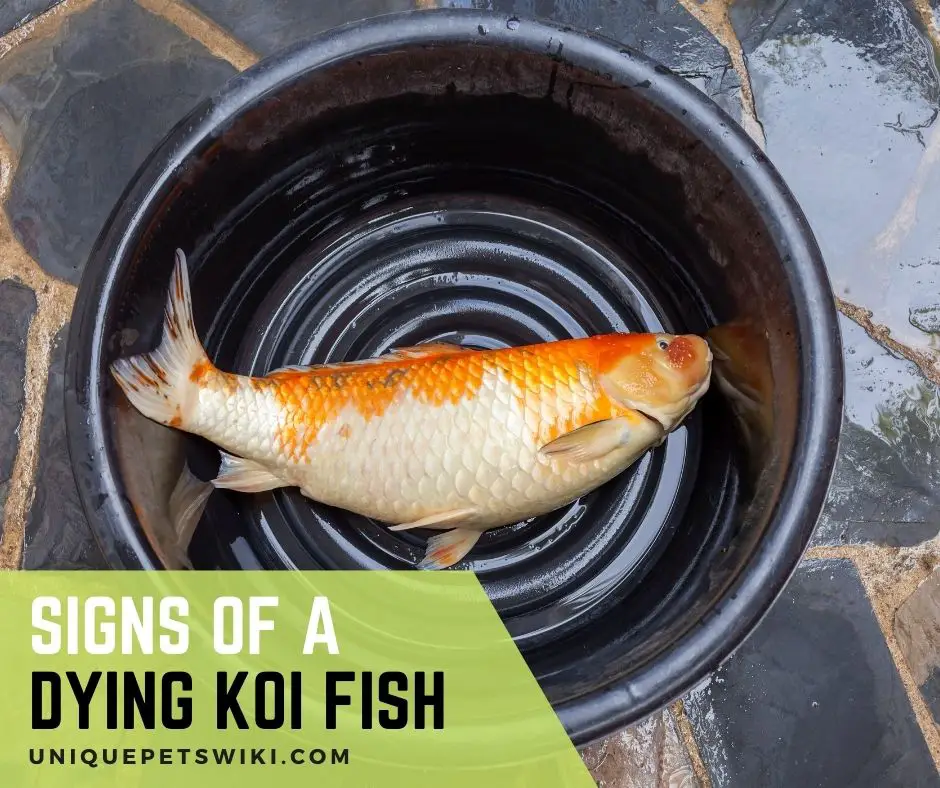If when reading “Signs Of A Dying Koi Fish” you’re in an emergency dilemma trying to rescue your koi fish from death, I would advise that you take your fish to see the vet.
While this article is designed to assist you through any health issue your koi fish is experiencing, note that it is not a ‘quickie magic guide’ that’ll just restore your dying fish to live.
Part of being a good keeper to your pet animal means reading and researching about caring for the animal before bringing it home. This includes reading about the potential illnesses and diseases, causes, symptoms, and treatments.
This way, you’ll be in a better position to prevent diseases in your animal rather than just reading and hoping to cure it. Hence, if you’re only researching for general knowledge, then this article is for you.
Learning about koi fish dying signs even before your fish shows any of these signs is one of the first steps to being a good keeper to your koi fish. With this knowledge, you can notice in time any major or minor symptoms of ill health before it gets worse.
Some of these early signs are not what a novice would easily see. But because you’re knowledgeable in the subject, you can tell that the fish is sick. The most important thing is to be able to recognize these symptoms in time, what the causes are, and how to treat/prevent them.
In the end, you’ll get value for reading this article and the goal will be achieved. Read carefully to the end.
Contents
8 Koi Fish Dying Signs
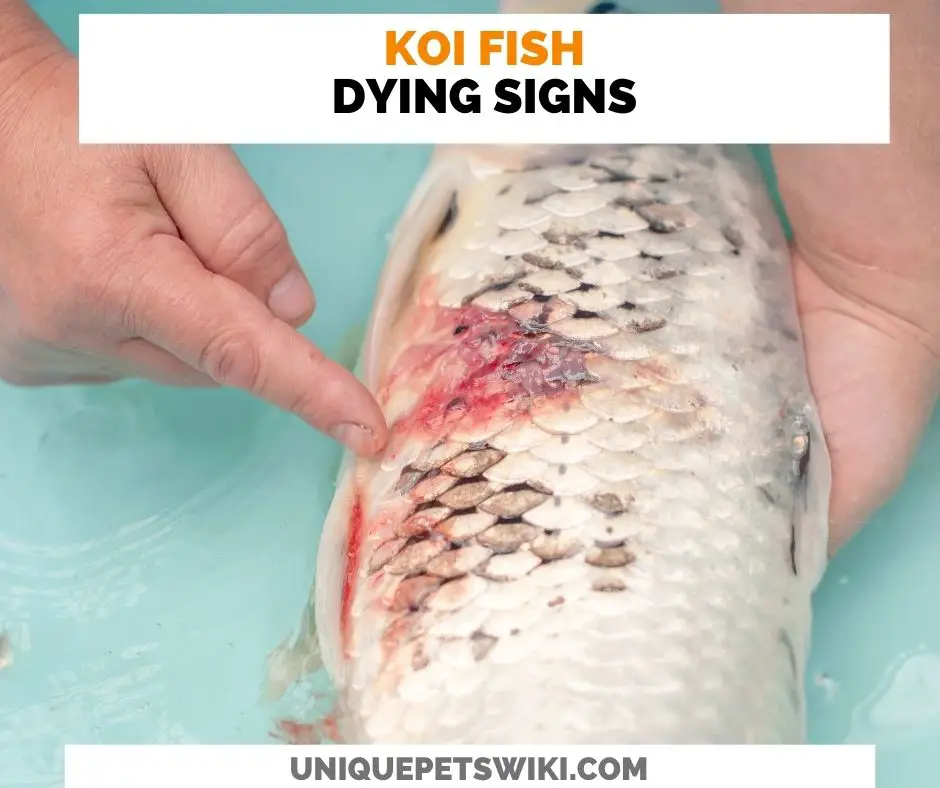
A healthy fish will not appear motionless for a long time or swim in a strange way. But a dying fish will.
You can tell that your koi fish is sick and near death, if it scales flaked off, rests on the bottom of the pond, and appears to float on one side.
Other dying symptoms of koi fish include:
- Isolation from others.
- Flashing (jumping out of the water).
- Rubbing itself against the wall, bottom of the pond, or any objects in the pond.
- Loss of appetite or erratic feeding.
- Assembling by the water flow.
- Floating or swimming slowly by the waterfall, drain, or return pipe.
- Keep fins close to its body.
- Body discoloration.
It’s a general law for sick animals to act differently from normal or healthy ones. The same thing will apply to your koi fish. For koi fish, sickness is usually caused by stress from their habitats.
When this happens, their immune system becomes weak and unable to fight off diseases and infections. Stress factors can be overcrowding, a drop in water quality, and contamination.
The most likely cause of disease in captive koi fish is poor water quality and water contamination. Since they live and breathe in the water, the pond water must be kept clean, safe, and free of chemicals.
Substances that can contaminate the water include fertilizers, pesticides, or even introducing a new ‘unquarantined’ fish to the pond.
When your koi fish gets sick of bacterial or parasitic infections because of poor water quality, symptoms do not take longer when it kills the fish. With this in mind, you should understand the importance of early detection and treatment.
Fortunately, this article seeks to help you detect when your koi fish is sick and what treatment to give depending on the symptoms displayed.
How To Tell If Your Koi fish Is Sick?
Beginners who aren’t familiar with how fishes behave may find it challenging to tell if any of their fishes are sick. A sick fish will have a change in behavior from what is perceived as normal to abnormal behaviors.
This behavior change may include swimming upside down, erratic swimming, isolation from others, loss of appetite, or abnormal feeding behavior.
You may also notice some physical changes on the body of the fish such as swollen abdomen, sores, popped or cloudy eyes, cuts, discolored or red gills, and many more.
All these signs and many others you’d see mean that your fish is sick. A close and careful examination will give you some clue as to what is wrong and what to fix.
20 Signs Of A Sick Koi Fish
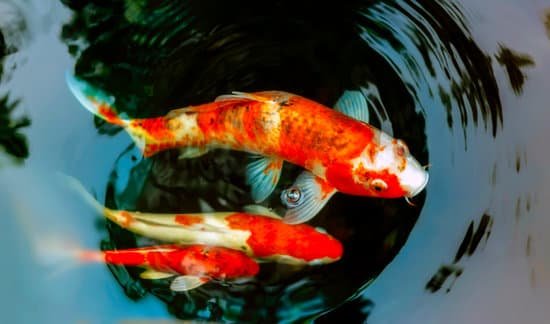
For easy understanding, signs of sickness in koi fish will be discussed in two categories. – The physical signs and behavioral signs.
The physical signs are what you can see on the fish’s body such as rashes, cuts, lumps, bumps, sores, and so on. Behavioral symptoms are abnormal behaviors also called body language that the fish will exhibit to indicate that it is in pain.
Behavioral symptoms include abnormal swimming, jumping out of the water (flashing), loss of appetite, isolation from others, lethargy, and many others.
You must understand that some of these sick signs are not easily noticeable since the fish is usually in the water. Besides, these symptoms can spread rapidly and may kill your fish quickly if not detected on time.
Hence, the earlier you can detect the symptoms for treatments, the better.
Physical Symptoms
Red Gills
Red or white gills, extending to the gill cover becoming white are all indications of bacterial infection that is damaging the gills.
These signs are as a result of chilodonella, ichthyobodo, dactylogyrus, gyrodactylus, columnaris disease, apiosoma, and myxobolus koi infection.
Popped Out Or Sunken In Eyes
When the eyes appear sunken in or popped out, it’s an indication of any of these diseases: pinecone disease, chilodonella, bloating of the abdominal region, hole disease, and columnaris.
Swollen Abdomen
A swollen abdomen is a sign of cold, intestinal thelohanellosis, and pinecone diseases.
Cloudy Or Swollen Eyes
Columnaris and hole diseases are often the cause of cloudy and swollen eyes.
A Whitish Or Yellowish Substance On The Body
This symptom is a sign of gill rot or columnaris disease. It is caused by chilodonella, ichthyobodo, dactylogyrus, gyrodactylus, white spot disease, and white cloud disease.
Besides having a whitish or yellowish substance on its body, these diseases are often associated with mucus and scales coming off. Thus, making the fish look as though covered in white rags.
A Whitish Cloud-like Mucus From The Body
This symptom can mean the presence of any of these diseases: – white spot disease, gyrodactylus, ichthyobodosis, trichodina, chilodonella, white cloud diseases, and cold.
Whitish spots on the body
This is a symptom of white spot disease.
Red Streaks On Fins
This symptom is caused by columnaris disease.
Flaked Scales
This symptom is also a sign of columnaris disease.
Behavioral Symptoms
Erratic Swimming
This is when your fish moves randomly up and down or unsteady and without a definite direction. Oftentimes, while swimming erratically, you’ll notice your fish’s body shivering (shaking). This condition in koi fish is caused by atrophic loin.
Swimming Upside Down
Swimming upside down or in a slow and uncoordinated way indicates anchor worm, imbalanced PH level, white spot disease, columnaris disease, and argulosis.
Isolation And Lethargy
Any diseases mentioned in this article can cause your koi fish to isolate itself from the rest of the stock and act lethargic.
Jumping Out Of Water
Fishes jump out of the water in the wild as a defense mechanism.
That is, to escape from predators or to hunt prey. However, when this happens repeatedly in captivity, it’s a sign that something is wrong in the aquarium.
Koi fish jumping out of the water always has to do with poor water quality and chemical contamination.
This is a sign of parasites and worm infestation. Especially anchor worms.
Breathing Difficulty
One major reason your pet koi fish will have difficulty breathing is oxygen deficiency. Besides, if there is any poisonous substance in the pond, the fish may experience difficulty breathing.
Other diseases that’ll cause breathing problems are red disease (molile), KHV, Aeromonas disease, and columnaris disease.
Ulcers (red sores)
Hanging Near The Water Surface Or A Waterfall
This is a sign of a hole disease, chilodonella, ichthyobodo, dropsy, dactylogyrus, gyrodactylus, white spot disease, columnaris disease, apiosoma, myxobolus koi infection, and edema disease.
Loss Of Appetite
Any disease no matter the type will make your koi fish lose interest in eating. From being lethargic and isolating itself from others to refusing to eat.
Loss of appetite is often one of the first signs you can use to tell that your koi is sick.
Rubbing Itself Against The Wall, Bottom Of The Pond, Or Any Objects In The Pond
When you see your koi fish rubbing itself against the wall or any objects in the pond, it means that the fish has been infested with parasites or worms and is trying to rub itself to get rid of the bugs. This condition in fish is called flashing.
As disturbing as this can be for humans, the same will happen to your fish. Constant rubbing against the wall will stress out the fish and may lead to death.
This symptom indicates the presence of anchor worm, argulosis, white spot disease, chilodonella, ichthyobodo, gyrodactylus, columnaris disease, myxobolus koi infection, and epistyliasis.
Fish Sitting Or Resting On The Bottom Of The Pond
This sign is an indication that the fish is suffering from any of these diseases: chilodonella, ichthyobodo, white spot disease, dactylogyrus, gyrodactylus, white spot disease, argulosis, myxobolus koi infection
Can You Treat A Sick Koi Fish?
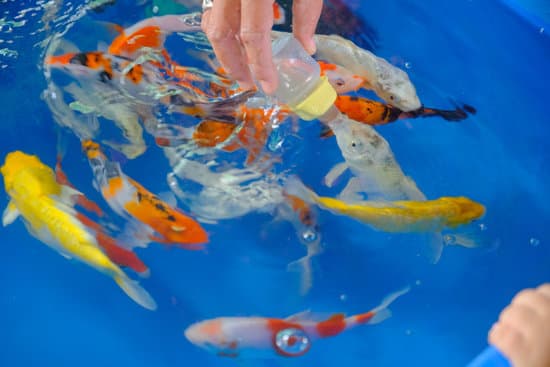
Yes, you can treat a sick koi fish. But it depends on what sickness or disease your fish is having and how severe it is.
External or body diseases such as pine cone disease, white spot disease, and anchor worm are easy to treat if detected on time. This will require you to first get the affected fish out of the pond and remove the sticking parasite/worm from its body using tweezers.
Smaller-sized worms that can’t be easily seen or removed with tweezers can be treated with a dewormed treatment.
Secondly, to ensure that the fish is completely healed and reduce the risk of spreading the parasite to other fish in the pond, treat the pond with Trichlorfon 0.2 – 0.5 ppm to kill the larvae.
Behavioral symptoms will require a broad spectrum treatment since many factors can be the reason for the behavior. What this means is that you’ll have to do a full pond cleaning, water treatment, and pond fish treatment.
To effectively do a pond fish treatment you need the service of an experienced vet. This is because your pond will be tested first before treatment.
Koi Fish Ill Symptoms That You Can Treat At Home
Koi fish sick symptoms that you can treat at home either by physically removing the parasites or treating the pond include:
Anchor Worm
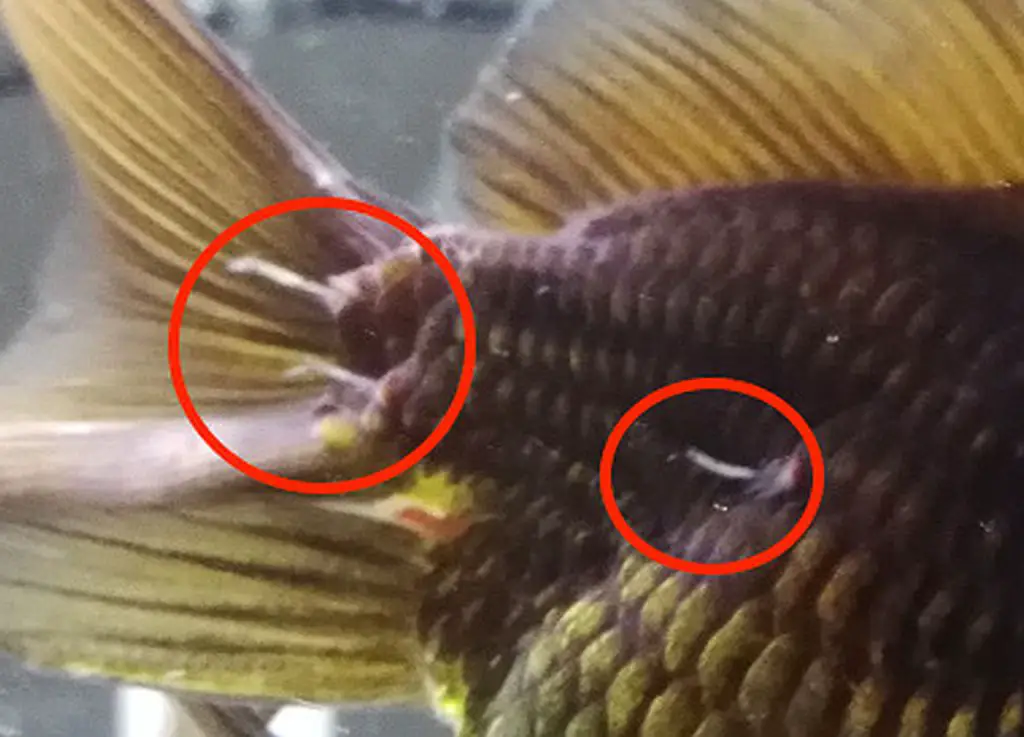
This disease usually occurs during spring to autumn when the water temperature is 59⁰ F or higher. To treat it at home, first hand pick or use tweezers to remove the worms from your fish body.
Secondly, treat the water with Trichlorfon 0.2 – 0.5 ppm to kill the worm’s larvae.
White Spot Disease
Your koi fish will have this disease if the water is constantly kept within the 43⁰ F – 77⁰ F temperature range.
Treatments for white spot disease will involve frequent and consistent baths with different antibacterial agents and increasing the water temperature to kill the life cycle of the parasites.
- First, bathe your affected koi fish with 5kg salt in 264 gallons of water for 5 – 7 days. Note that if you keep a large fish pond and will require more water for all your fish, the more the water, the more the quantity of salt you should use.
- After this first 5 – 7 days bath, increase the amount of salt to 10kg per 264 gallons of water and bathe for an hour daily for 3 days.
- Once the first two sets of baths are completed, bathe for 3 more days using 2g of methylene blue per 264 gallons of water.
- After the methylene bath, use 0.1g – 0.2g of malachite green for the next 3 days. While doing this, ensure to increase the water temperature to 82⁰ F and above. This will ensure that the parasites are completely eradicated.
Fish Lice (Argulosis)
Like with anchor worms, fish lice that will cause erratic swimming in your koi fish often occur from spring to autumn and when the water temperature is kept at 59⁰ F or higher.
Treatments for lice involve first removing the lice with tweezers and treating the pond with Trichlorfon 0.2 – 0.5 ppm. The same as with anchor worms.
Pine Cone Disease
This disease is often seen during early spring. It can be treated in the following ways:
- Bathe for 5 – 7 days using oxytetracycline with 5kg salt per 264 gallons of water.
- Once this is done, continue bathing with oxolinic acid and 5kg – 6kg salt per 264 gallons of water for the next 5 – 7 days. While giving these bath treatments, ensure that your water quality is optimal. Keep COD under 5ppm.
- When feeding, mix their food with 0.1g of oxolinic acid per 1g koi weight and feed it to the affected fish. For instance, if your fish is weighing 5kg, you’ll need to mix 0.5g of oxolinic acid into its food.
- In a nutshell, if after giving these treatments no result is seen, consult your vet.
Gill, Mouth, and Fin Rot
This disease often happens when the water temperature is 68 degrees F or higher. If not detected on time can kill the fish.
Start treatment with 6kg – 7kg of salt per 264 gallons of water. After this, use 6kg of salt with oxytetracycline per 264 gallons of water and continue with 5kg – 6kg of salt with oxolinic acid per 264 gallons of water for 10days respectively.
For a comprehensive list of diseases you can treat at home and what steps to take, visit Kodama koi farm
When Do You Need A Vet?
Any treatment that has to do with parasite removal, worm removal, bath with antibacterial agents are what you can treat with ease on your own.
Treatments that require removal of pus from the scales/ear or any other part and full pond fish treatment must be done by a vet.
Koi Fish Sick Symptoms That You Need A Vet

Symptoms that you need a vet but are not limited to, include:
- Breathing difficulty.
- Body discoloration.
- Hole disease.
- Swollen abdomen
- Cloudy or swollen eyes
- A whitish or yellowish substance on the body
- A whitish cloud-like mucus from the body
- Whitish spots on the body
- Red streaks on fins
- Erratic swimming
- Swimming upside down
- Isolation and lethargy
- Flashing (jumping out of water)
- Ulcers (red sores)
- Hanging near the water surface or near a waterfall
- Fins clamped close to its body
- Loss of appetite
- Rubbing itself against the wall, bottom of the pond, or any objects in the pond
- Fish sitting or resting on the bottom of the pond
To get your answer replied quickest, please visit some fish vet online source such as justanswer.com
How To Help Prevent Sickness In Koi Fish
To prevent diseases in pet koi fish is cheaper than cure. In severe cases, you may lose your fish before your vet could treat it.
Since the bulk of the diseases is caused by poor water quality, the importance of good water quality and appropriate temperature cannot be overstated.
Failure to keep their pond clean and free of chemicals can cause stress that’ll affect your fish’s immune system. Keep in mind that when they can’t fight off parasites and bacteria naturally, they fall sick and die.
Thus, the keyword to healthy living in captivity is good husbandry. Appropriate water quality and temperature as they would be exposed to in the wild.
That said, here are a few tips to prevent diseases and sickness in your koi fish:
- Proper Nutrition: Diet doesn’t cause harm as unhygienic and contaminated water does. Nonetheless, ensure that you give your koi fish appropriate food and in the right proportion.
- Poops: Watch out for any abnormalities in its poops.
- Maintain good pond/water hygiene at all times. Ensure that the water isn’t contaminated. Ammonia is one of those chemicals that will contaminate your pond and kill your koi fish even without your notice. Note that your pond must have 0% ammonia at all times.
- Constantly test the water to be sure it’s ammonia-free. One way ammonia will naturally get in your pond is through leftover food and decayed plants. That said, ensure that you check back the pond after feeding your fish to clean out any leftover food as well as cleanout any dead plants.
- Quarantine any sick and infected koi. All your healthy fish can get sick and die if a sick fish is introduced into the pond. Hence, before bringing in a new fish ensure that adequate health checks have been done.
- Ensure that your filters and skimmers are working perfectly.
- Have a functioning water filtration and ensure that you test the water regularly to enable you to detect a problem or an imbalance in time.
- Have a regular clean-up routine to ensure that your fish pond is always kept clean.
- Ensure that appropriate temperature and humidity levels are maintained in the water. Lack of sufficient air is the major reason for breathing difficulty and gill problems.
- Since your fish isn’t a terrestrial animal, you may not need to weigh it regularly. If you get your fish out of the water every now and then, you’ll cause stress to the fish. This will in no long time affect their immune system. Hence, avoid handling to keep stress out.
- Overcrowding is another major reason for sickness in pet koi fish. Avoid overcrowding your pond.
- Look out for changes in your fish’s behavior because this is often a sign of sickness.
- Physical Body Examination and Handling: Getting your fish out of the water to physically inspect or handle it every now and then, can cause stress to the fish. Avoid doing that. You can inspect your fish from a close range while it is in the tank.
Wrapping Up
When it comes to signs of a dying koi fish, the list is endless. Telling what disease or sickness your koi fish is having from the signs can be a challenge sometimes. This is because some of the signs appear similar but with different causes and treatments.
This is why it’s easy to mistake a particular disease to be the reason for a symptom. For this reason, a proper professional diagnosis is recommended before any treatment is given.
As discussed in this article, poor husbandry in the area of poor water quality is often the major cause of diseases in pet koi fish. This means you must ensure you have clean and fresh water free from contaminated substances in your pond.
That said, to keep a healthy pond you must adhere to all do’s and don’ts in this article. Keep in mind that proper diagnosis and treatment can save your dying fish. Hence, do not hesitate to speak to your vet when the need arises.
